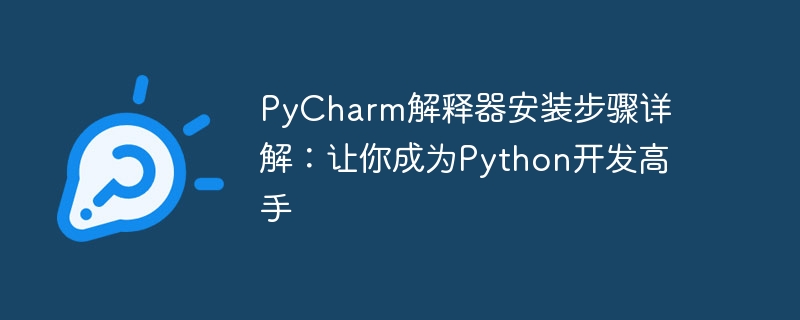

PyCharm is a popular Python integrated development environment (IDE) that has very powerful functions and usability in the field of Python development. Among them, installing the interpreter is an important step in the PyCharm development environment. This article will introduce the steps of installing the PyCharm interpreter in detail and provide specific code examples to help readers quickly master this key skill and become a Python development master.
1. Download PyCharm
First, open the browser and enter the JetBrains official website and find the official download page of PyCharm. Select the appropriate version to download based on your operating system and wait for the download to complete. Once the download is complete, double-click the installer to install it.
2. Open PyCharm
After the installation is complete, find the PyCharm icon on the start menu or desktop, and double-click to open PyCharm. When you open PyCharm for the first time, you may be prompted to select settings such as color schemes and key bindings. Just set them according to your personal preferences. Then, enter the PyCharm main interface.
3. Configure the interpreter
In the upper right corner of the PyCharm main interface, you can see a blue " " symbol. Click the symbol to select "Add Python Interpreter", and then the "Add Python Interpreter" window.
In the "Add Python Interpreter" window, you can select an existing Python interpreter in the system, or you can choose to install a new interpreter. It is generally recommended to choose an interpreter that is already in the system, so that there is no need to install the Python interpreter again. After selecting the interpreter, click the "OK" button.
4. Create a new project
Next, select "File" -> "New Project" in the PyCharm main interface to create a new Python project. In the new project settings, you can customize information such as the project name and save path. After completing the settings, click the "Create" button.
5. Write code
Now you can write Python code in PyCharm. In the structure of the project, you can see a file named "main.py". Double-click to open the file and write Python code in it. For example, you can enter the following code:
print("Hello, PyCharm!")6. Run the code
After completing the code writing, you can click the green triangle button on the toolbar or press the shortcut key "Shift F10" to run the code . PyCharm will output "Hello, PyCharm!" on the console, indicating that the code runs successfully.
Through the above steps, readers can successfully install PyCharm and configure the interpreter, and at the same time, they can run Python code. Mastering these basic skills is the basis for becoming a master of Python development. I hope that the specific code examples in this article can help readers gain a deeper understanding of the installation steps of the PyCharm interpreter, thereby improving Python development capabilities.
The above is the detailed content of Detailed explanation of the installation steps of PyCharm interpreter: Let you become a Python development expert. For more information, please follow other related articles on the PHP Chinese website!
 How to change pycharm to Chinese
How to change pycharm to Chinese
 pycharm installation tutorial
pycharm installation tutorial
 How to solve the problem that pycharm cannot find the module
How to solve the problem that pycharm cannot find the module
 How to install pycharm
How to install pycharm
 The difference between python and pycharm
The difference between python and pycharm
 How to configure the pycharm environment
How to configure the pycharm environment
 How to install the pycharm interpreter
How to install the pycharm interpreter
 What does pycharm mean when running in parallel?
What does pycharm mean when running in parallel?




